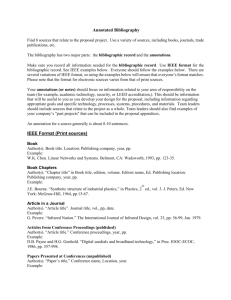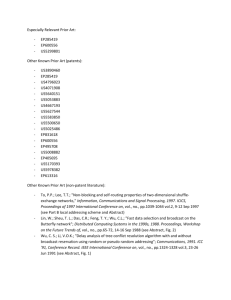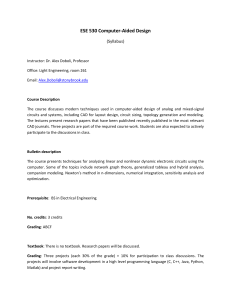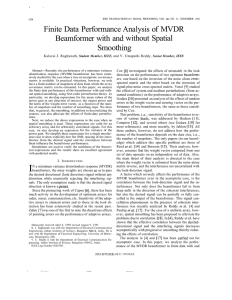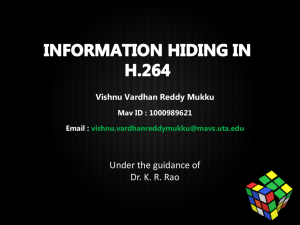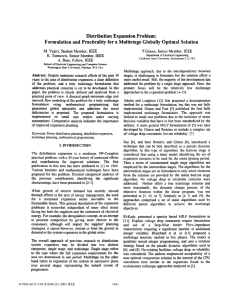DOC - Queen`s Computational Science and Engineering
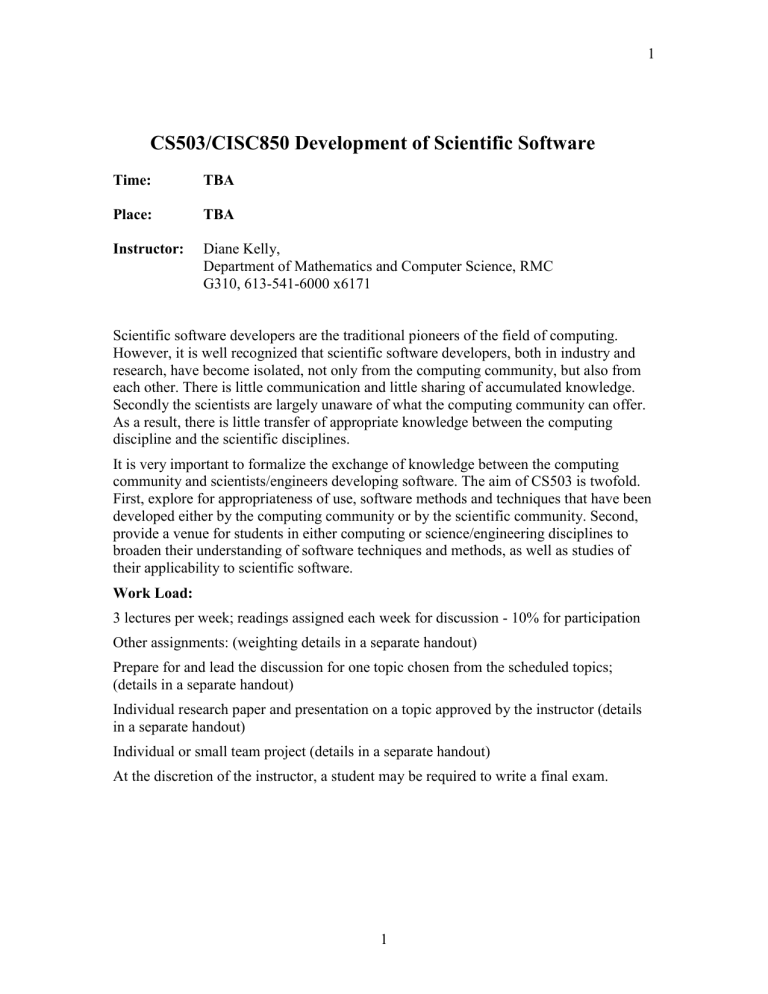
1
CS503/CISC850 Development of Scientific Software
Time: TBA
Place: TBA
Instructor: Diane Kelly,
Department of Mathematics and Computer Science, RMC
G310, 613-541-6000 x6171
Scientific software developers are the traditional pioneers of the field of computing.
However, it is well recognized that scientific software developers, both in industry and research, have become isolated, not only from the computing community, but also from each other. There is little communication and little sharing of accumulated knowledge.
Secondly the scientists are largely unaware of what the computing community can offer.
As a result, there is little transfer of appropriate knowledge between the computing discipline and the scientific disciplines.
It is very important to formalize the exchange of knowledge between the computing community and scientists/engineers developing software. The aim of CS503 is twofold.
First, explore for appropriateness of use, software methods and techniques that have been developed either by the computing community or by the scientific community. Second, provide a venue for students in either computing or science/engineering disciplines to broaden their understanding of software techniques and methods, as well as studies of their applicability to scientific software.
Work Load:
3 lectures per week; readings assigned each week for discussion - 10% for participation
Other assignments: (weighting details in a separate handout)
Prepare for and lead the discussion for one topic chosen from the scheduled topics;
(details in a separate handout)
Individual research paper and presentation on a topic approved by the instructor (details in a separate handout)
Individual or small team project (details in a separate handout)
At the discretion of the instructor, a student may be required to write a final exam.
1
2
Scheduled topics:
Topic
(1) Software quality as a tool for assessment and improvement
(2) Risks involved in building scientific software
Goal for this topic
Provide an understanding of the meaning and difficulties associated with quality for scientific software.
A look at the social and technical issues that contribute to the risks of building scientific software.
Reading list
Les Hatton, Andy Roberts, “How Accurate is
Scientific Software?”, IEEE Transactions on
Software Engineering, Vol. 20, N0. 10,
October, 1994, pp. 785-797
Les Hatton, “The Chimera of Software
Quality”, IEEE Computer, August 2007, pp.102-104
D.E. Stevenson, “A Critical Look at Quality in Large-Scale Simulations”, Computing in
Science and Engineering, May-June 1999, pp. 53-63
Judith Segal, “Some Problems of
Professional End-User Developers”, to appear in VL/HCC 2007, 8 pages
Douglass E. Post, Lawrence G. Votta,
“Computational Science Demands a New
Paradigm”, Physics Today, January 2005, pp. 35-41 plus letters August 2005
Richard P. Kendall, Douglass E. Post, Jeffrey
C. Carver, Dale B. Henderson, David A.
Fisher, “A Proposed Taxonomy for Software
Development Risks for High-Performance
Computing (HPC) Scientific/Engineering
Applications”, Technical Notes CMU/SEI-
2006-TN-039, January 2007, 31 pages
(3) Design and
Implementation
- I
Architectural styles, design patterns, object oriented analysis and design, and information hiding are examined in terms of the needs of computational scientific software.
Dorian C. Arnold, Jack J. Dongarra,
“Developing an Architecture to Support the
Implementation and Development of
Scientific Computing Applications”, in The
Architecture of Scientific Software, ed.
Ronald F. Boisvert, Ping Tak Peter Tang,
Kluwer Academic Publishers, 2000
Ian Foster, Carl Kesselman, “Scaling
System-Level Science: Scientific
Exploration and IT Implications”, IEEE
Computer, November 2006, pp. 31-39
Robert B. Laughlin, “The Physical Basis of
Computability”, Computing in Science and
Engineering, May/June 2002, pp. 27-30
2
3
(4) Design and
Implementation
- II
(5) Open
Source
(6)
Development process
The implementation stage for scientific software is ultimate focus of effort in solving the application domain problem. Here we look at implementation issues including languages, assumptions, constraints, maintainability, and verifiability.
Charles Blilie, “Patterns in Scientific
Software: An Introduction”, Computing in
Science and Engineering, May/June 2002, pp.48-53 (** I don't agree with a lot of what this author says but I can't find a really good paper on design patterns for scientific software!)
Viktor K. Decyk, Charles D. Norton, Hanry
J. Gardner, “Why Fortran?”, Computing in
Science and Engineering, July/August 2007, pp. 68-71
Open source is seen as both a significant advance in software development paradigms and as a flavour-of-themonth that is not selfsustaining. We look at what OS means in general and specifically for scientific software development.
Given the goals and needs of scientific software development, we explore the different development processes for their appropriateness and useful practices for scientific software development.
Charles Norton, Viktor Decyk, Boleslaw
Szymanski, Henry Gardner, "The Transition and Adoption of Modern Programming
Concepts for Scientific Computing in
Fortran", Scientific Programming, Vol. 15, no. 1, spring 2007, 27 pages
Eric S. Raymond, “The Cathedral and the
Bazaar”, first presented at Linux Kongress,
May 1997, www.firstmonday.org/issues/issue3_3/raymo nd/#d1
Michael W. Godfrey, Qiang Tu, “Evolution in Open Source Software: A Case Study”,
Proceedings International Conference in
Software Maintenance, 2000, pp. 131-142
W. Scacchi, “Understanding the
Requirements for Developing Open Source
Software Systems”, IEE Proceedings –
Software, Vol. 149, No. 1, February 2002, pp. 24-39
Craig Larman, Victor R. Basili, “Iterative and Incremental Development: A Brief
History”, IEEE Computer, June 2003, pp.47-
56
William A. Wood, William L. Kleb,
“Exploring XP for Scientific Research”,
IEEE Software, May/June 2003, pp.30-36
D.E.Post, R.P.Kendall, “Software Project management and Quality Engineering
Practices for Complex, Coupled
Multiphysics, Massively Parallel
Computational Simulations: Lessons
3
4
(7) Software
Inspection
(8) Testing - overview
(9) Testing - techniques
Inspection is recognized as the most cost-effective method of evaluating software. We will look at both traditional definitions of inspection and the newer variations.
Learned from ASCI”, The International
Journal of High Performance Computing
Applications, Vol. 18, No. 4, winter 2004, pp.399-416
Victor Basili, “Evolving and Packaging
Reading Technologies”, Journal of Systems and Software, Vol. 38, 1997, pp. 3-12
David L. Parnas, David M. Weiss, “Active
Design Reviews: Principal and Practices”,
Proceedings 8 th
International Conference on
Software Engineering, London, August
1985, pp.132-136
Les Hatton, “Testing the Value of Checklists in Code Inspections”, www.leshatton.org/Documents/checklists_in
_inspectins.pdf
, (published web only),
January 2007
Scientists are dealing with software that is difficult to test. This is an overview of testing as described by the computing community.
We'll do some comparisons with what scientists may need.
David Talby, Arie Keren, Orit Hazzan, Yael
Dubinsky, “Agile Software Testing in a
Large-Scale Project”, IEEE Software,
July/August 2006, pp. 30-37
Marc Eistenstadt, “My Hairiest Bug War
Stories”, Communications of the ACM,
April 1997, Vol. 40, No. 4, pp. 30-37
Glenford J. Meyers, Software Reliability
Principles and Practice, Chapter 10: "Testing
Principles", A Wiley-Interscience
Publication, 1976, pp. 169-195
There are a myriad of techniques available.
Some of the betterknown standard techniques are presented.
Discussion of weaknesses and strengths of the different techniques.
W.E. Howden, "Applicability of Software
Validation Techniques to Scientific
Programs", ACM Transactions on
Programming Languages and Systems, Vol.
2, No. 3, July 1980, pp. 307-320
Natalia Juristo, Ana M. Moreno, Sira Vegas,
Martin Solari, “In Search of What We
Experimentally Know about Unit Testing”,
IEEE Software, November/December 2006, pp. 72-80
James H. Andrews, Lionel C. Briand, Yvan
Labiche, Akbar Siami Namin, “Using
Mutation Analysis for Assessing and
Comparing Testing Coverage Criteria”,
4
5
(10) Formal specifications and verification
Formal methods have been used for safety critical software, which is often real-time control software. The appropriateness and use of formal methods for scientific computational software is explored.
IEEE Transactions on Software Engineering,
Vol. 32, No. 8, August 2006, pp. 608-624
Daniel M. Berry, “Formal Methods: The very idea, some thoughts about why they work when they work.” Electronic Notes in
Theoretical Computer Science, Vol. 25,
1999, 13 pages, www.elsevier.nl/locate/entcs/volume25.html
Michael Jackson, “What can we expect from program verification?”, IEEE Computer,
October 2006, pp. 65-71
Spencer Smith, “Systematic Development of
Requirements Documentation for General
Purpose Scientific Computing Software”,
14 th
IEEE International Conference on
Requirements Engineering, 2006, pp.209-
218
5



